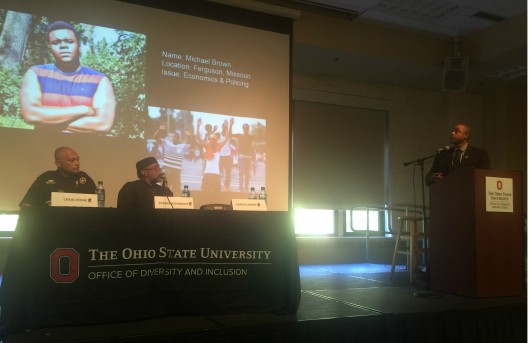
University Police Acting Chief Craig Stone (left) and Dennis Alexander, a psychologist with OSU’s Counseling and Consultation Service (center), with Charles Noble, a legal policy analyst for the Kirwan Institute for the Study of Race and Ethnicity (right), discuss the shooting of Michael Brown during the Office of Diversity and Inclusion’s Protect and Serve discussion on Thursday. Credit: Aubrey Cornwell / Lantern reporter
The Ohio State Office of Diversity and Inclusion held one in a series of Protect and Serve discussions Thursday in Hale Hall, focusing on the relationships and struggles between law enforcement and the public.
The three panelists leading the discussion were Charles Noble, a legal policy analyst for the Kirwan Institute for the Study of Race and Ethnicity; Dennis Alexander, a psychologist with OSU’s Counseling and Consultation Service and Craig Stone, the OSU acting chief of police.
“We wanted to create a safe space in an informal manner where we can come together and talk about some of the issues,” said Robert Decatur, the director of the ODI Scholars Program, when introducing the purpose of the Protect and Serve discussion series.
For the four years that these series have been held, the ODI decide what topic they’re going to discuss based on current events. This year, the focus was on the conflict between police and their enforcement of the law with black Americans.
Noble began the discussion by introducing various cases that involved police officers killing black Americans and the underlying issues of these killings.
“There is this perception of black males, of people of color as ‘the other.’ It is this perception that drives a lot of fear, that drives a lot of anxiety … that are really counterintuitive I think to us working together to solve these issues,” Noble said.
Alexander continued the discussion by focusing on the impacts of the media coverage and the images of protests and movements that are flooding the news outlets, such as the slogan “hands up, don’t shoot” that was commonly used after the killing of Michael Brown in Ferguson, Missouri.
Brown, an unarmed black man, was fatally shot by police officer Darren Wilson on Aug. 9. It was announced on Nov. 24 that Wilson will not face criminal charges.
“The killing of black men and boys has almost become an epidemic, and that begins to be a problem,” Alexander aid. “We have to think about the impact that all of this is having on all of us, as a society.”
He also touched on how cooperation and communication can help solve the issue between law enforcement and the public.
“When you know how to handle and manage things, things don’t get out of line. You don’t create the perception of a threat,” Alexander said. “That’s what I think is missing sometimes in the community.”
Stone wrapped up the Protect and Serve discussion with solutions on the law enforcement end to help reduce these killings, such as equipping police officers with body cameras to detect police misconduct.
Stone also presented a study performed by the FBI that showed the shootings in America that occurred between 2000 and 2013, disregarding race or ethnicity.
“There were 160 active shooter incidents in the U.S., 486 killed, 557 wounded. These are things, folks, that shouldn’t be acceptable,” he said.
Some students said they were pleased about the topic of discussion and what the panelists had to say.
Alaina McEachin, a law student, said she thought the discussion was informative.
“It seemed like a really relevant topic that needed to be talked about,” McEachin said.
Angela Borgerding, a graduate student in social work, came because she wanted to hear about the relationship between the police force and the community.
“I liked how they focused a lot on not just condemning the police or the victim population but rather saying it’s more of a general need for understanding both the police side and the minority,” Borgerding said.
A follow-up discussion on the relationships and struggles between the police and the community will be held on Oct. 8, titled “Protect and Serve: From Crisis to Collaboration.”


